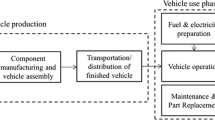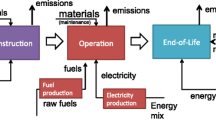Abstract
Purpose
The purpose of the study is to compare the performances of two passenger cars: an electric vehicle (EV) and an internal combustion engine vehicle (ICEV) paying particular attention to the production of electricity that will charge the EV. Even if many similar comparative life cycle assessments (LCAs) exist (Nordelöf et al. J Life Cycle Assess 19(11):1866–18990, 2014), only few have focused their attention on evaluating which is the kind of electricity that will recharge EV batteries (Hawkins et al. Int J Life Cycle Assess 17(8):997–1014, 2012).
Methods
Despite its relevance, many EV LCA studies have used a ready-to-use dataset to evaluate the power mix that supplies electricity to EV. The present paper tries to better define the power mix that recharges EV batteries in Italy according to the national power system and the national electric market rules. A 2013 and a 2030 scenario have been developed in order to understand effects in short and middle term. Life cycle inventory of electricity for EV has been estimated modifying available datasets according to official Italian data on power plants’ efficiency and emission rates. Finally, also for the ICEV use phase, existing dataset have been modified for fuel consumption and regulated emission according to the National Inventory Report results (ISPRA 2014)
Results and discussion
In both 2013 and 2030 scenarios, the power mix that in Italy supplies energy to EV is dominated by fossil fuel power plants. Nevertheless, due to the fact that more than the 60 % of this energy is produced in efficient combined cycle gas turbine power plants, EV performs better than ICEV in almost all the impact categories considered except for human toxicity and eutrophication, the only two impact categories in which the EV car, mainly due to battery manufactory, presents more relevant potential impacts. ICEV impacts are always dominated by well to wheel phases (use phase and fuel production). EV car and battery manufacturing have higher impacts for all categories than ICEV car manufacturing.
Conclusions
The study demonstrates that electricity supplied in Italy to EV today is, and will probably be in 2030, mainly produced by fossil fuel power plants. Nevertheless, the EV proves to be able to reduce, with respect to ICEV, those impacts it is supposed to reduce: air acidification, photochemical oxidant formation, and also greenhouse gases. Trade-offs are, as foreseeable, eutrophication and human toxicity due to EV car and battery manufacturing.























Similar content being viewed by others
Notes
Ecoinvent v2.2, passenger car, RER [unit] (#1936)
Ecoinvent v2.2, passenger car, electric, LiMn2O4, at plant, RER [unit] (#11,774)
References
Amarakoon S, Smith J, Segal B (2013) Application of life-cycle assessment to nanoscale technology: lithium-ion batteries for electric vehicles. No. EPA 744-R-12-001
Anair D, Mahmassani A (2012) State of charge: electric vehicles’ global warming emissions and fuel-cost savings across the United States. UCS Publications, 2 Brattle Square Cambridge, MA 02138–3780
Azadfar E, Sreeram V, Harries D (2015) The investigation of the major factors influencing plug-in electric vehicle driving patterns and charging behaviour. Renew Sust Energ Rev 42:1065–1076
Borgarello M, Benini M, Gelmini A, Cavicchioli C (2008) The use of the MATISSE modelling system to assess the economic implications of GHG emissions reduction for the Italian electricity sector. CIGRÉ General Session, 24–29 August 2008, Paris
Cavicchioli C, Gargiulo M, Lavagno E, Vitale S (2006) The Italian electricity sector: a regional and multi grid TIMES model. International Energy Workshop 2006, 27–29 June 2006, Cape Town
Celaschi S, Colzi F, Gianinoni I, Savaresi S, Corti A (2013) Sostenibilità economica e problematiche tecniche aperte dalla mobilità elettrica ed ibrida alla luce di studi e sperimentazioni su veicoli reali. RSE report 12000993 http://www.rse-web.it/documenti/documento/314710
Contaldi M, Gracceva F, Tosato G (2007) Evaluation of green-certificates policies using the MARKAL-MACRO-Italy model. Energ Policy 35(2):797–808
Dunn JB, Gaines L, Sullivan J, Wang MQ (2012) Impact of recycling on cradle-to-gate energy consumption and greenhouse gas emissions of automotive lithium-ion batteries. Environ Sci Technol 46(22):12704–12710
Duvall M, Knipping E, Alexander M, Tonachel L, Clark C (2007) Environmental assessment of plug-in hybrid electric Vehicle’s. Volume 1: Nationwide Greenhouse Gas Emissions. EPRI, Palo Alto, CA: 2007. 1015325
Ecoinvent Database v 2.2 (2010) Swiss Centre for Life Cycle Inventories. http://www.ecoinvent.org
EEA, EMEP (2009) EEA air pollutant emission inventory guidebook—2009.European Environment Agency (EEA), Copenhagen
Elgowainy A, Burnham A, Wang M, Molburg J, Rousseau A (2009) Well-to-wheels energy use and greenhouse gas emissions analysis of plug-in hybrid electric vehicles. Argonne National Laboratory. ANL/ESD/09-2
Frischknecht R, Rebitzer G (2005) The Ecoinvent database system: a comprehensive web-based LCA database. J Clean Prod 13(13):1337–1343
Gao L, Winfield ZC (2012) Life cycle assessment of environmental and economic impacts of advanced vehicles. Energies 5(3):605–620
Girardi P (2012) Ibridi plug-in e veicoli elettrici: vantaggi e svantaggi secondo un approccio LCA. Rapporto RdS RSE prot. 12001047
Girardi P (2013) Auto elettrica: un opportunità o un rischio per l’ambiente?, L’Energia Elettrica, aprile 2013
GME (2012) Annual Report www.gme.it
Guinée JB, Gorrée M, Heijungs R, Huppes G, Kleijn R, Koning Ad, Oers LV, Wegener Sleeswijk A, Suh S, Udo de Haes HA, Bruijn Hd, Duin Rv, Huijbregts MAJ (2002) Handbook on life cycle assessment. Operational guide to the ISO standards. I: LCA in perspective. IIa: Guide. IIb: Operational annex. III: Scientific background. Guinée JB. Centrum Milieukunde Leiden (CML), Leiden University. Kluwer, Dordrecht
Hacker F, Harthan R, Matthes F, Zimmer W (2009) Environmental impacts and impact on the electricity market of a large scale introduction of electric cars in Europe Critical Review of Literature. ETC./ACC Technical Paper 2009/4
Hawkins T, Gausen O, Strømman A (2012) Environmental impacts of hybrid and electric vehicles—a review. Int J Life Cycle Assess 17(8):997–1014
Hawkins TR, Singh B, Majeau‐Bettez G, Strømman AH (2013) Comparative environmental life cycle assessment of conventional and electric vehicles. J Ind Ecol 17(1):53–64
Hearron JD, McDonough M, Ranjbar A, Wei W, Chenjie L, Shamsi P, Manohar S, Fahimi B (2011) The sustainability of new technologies in vehicular transportation. In: 2011 I.E. Vehicle Power and Propulsion Conference, Piscataway, NJ, USA, 6–9 Sept. 2011. 2011 I.E. Vehicle Power and Propulsion Conference. IEEE. doi:10.1109/vppc.2011.6043194
ICCT, International Council on Clean Transportation (2013) European Vehicle Market Statistics Pocketbook 2013
ISO (2006) Environmental management—life cycle assessment—principles and framework, ISO 14040:2006. International Organization for Standardization, Geneva
ISPRA (2014) Italian Emission Inventory—Informative Report 2014 http://www.sinanet.isprambiente.it/it/sia-ispra/serie-storiche-emissioni/informative-inventory-report-2012/view
ISTAT (2008) Demographic forecasts. demo.istat.it/uniprev/index.html?lingua=ita
JRC (2011) ILCD Handbook: Recommendations for Life Cycle Impact Assessment in the European context. First Edition, EUR 24571 EN – 2011
Lanati F, Benini M, Gelmini A (2011) Impact of the penetration of electric vehicles on the Italian power system: a 2030 scenario. IEEE Power Energy Soc Gen Meet 1(8):24–29
Loulou R, Goldstein G, Noble K (2004) Documentation for the MARKAL Family of Models. ETSAP. http://www.iea-etsap.org/web/Times.asp
Loulou R, Remne U, Kanudia A, Lehtila A, Goldstein G (2005) Documentation for the TIMES Model - PART I 1–78. http://www.iea-etsap.org/web/Times.asp
MacPherson ND, Keoleian GA, Kelly JC (2012) Fuel economy and greenhouse gas emissions labelling for plug-in hybrid vehicles from a life cycle perspective. J Ind Ecol 16(5):761–773
Majeau-Bettez G, Hawkins TR, Singh B, Strømman AH (2011) Life cycle environmental assessment of lithium-ion and nickel metal hydride batteries for plug-in hybrid and battery electric vehicles. Environ Sci Technol 45:4548–4554
Mathiesen BV, Münster M, Fruegaard T (2009) Uncertainties related to the identification of the marginal energy technology in consequential life cycle assessment. J Clean Prod 17(5):1331–1338
Nemry F, Leduc G, Alumdena M (2010) State of the research and development and comparative analysis of energy and cost efficiency. JRC Technical Note JRC 54699. European Commission, Luxembourg
Nemry F, Leduc G, Mongelli I, Uihlein A (2008) Environmental Improvement of Passenger cars (IMPRO-car). Institute for Prospective Technological Studies
Nitta N, Wu F, Lee JT, Yushin G (2014). Li-Ion battery materials: present and future. Mater today
Nordelöf A, Messagie M, Tillman A, Ljunggren Söderman M, Van Mierlo J (2014) Environmental impacts of hybrid, plug-in hybrid, and battery electric vehicles—what can we learn from life cycle assessment? Int J Life Cycle Assess 19(11):1866–1890
Notter DA, Gauch M, Widmer R, Wager P, Stamp A, Zah R, Althaus H (2010) Contribution of Li-ion btteries to environmental impact of electric vehicles. Environ Sci Technol 44:6550–6556
Ntziachristos L, Gkatzoflias D, Kouridis C, Samaras Z (2009) COPERT: a European road transport emission inventory model. In Inf. technologies in environmental engineering (pp. 491–504). Springer Berlin Heidelberg
Offer GJ, Howey D, Contestabile M, Clague R, Brandon NP (2010) Comparative analysis of battery electric, hydrogen fuel cell and hybrid vehicles in a future sustainable road transport system. Energ Policy 38(1):24–29
Pasaoglu G, Fiorello D, Martino A, Zanic L, Zubaryevaa A, Thiel C (2013) Travel patterns and the potential use of electric cars—results from a direct survey in six European countries. Technol Forecast Soc 87:51
Rosenbaum RK, Bachmann TM, Gold LS, Huijbregts MA, Jolliet O, Juraske R, Hauschild MZ (2008) USEtox—the UNEP-SETAC toxicity model: recommended characterisation factors for human toxicity and freshwater ecotoxicity in life cycle impact assessment. Int J Life Cycle Assess 13(7):532–546
Sharma R, Manzie C, Bessede M, Crawford RH, Brear MJ (2013) Conventional, hybrid and electric vehicles for Australian driving conditions. Part 2: Life cycle CO2-e emissions. Transport Res C-Emer 28:63–73
Sullivan JL, Gaines L (2010) A review of battery life-cycle analysis: state of knowledge and critical needs (trans: Center for Transportation Research ESD). ANL report. Argonne National Laboratory, U.S. Department of Energy, Argonne, Illinois. (Review report ANL/ESD/10-7)
Szczechowicz E, Dederichs T, Schnettler A (2012) Regional assessment of local emissions of electric vehicles using traffic simulations for a use case in Germany. Int J Life Cycle Assess 17(9):1131–1141
TERNA (2013) Statistical Data, General Data, http://www.terna.it
UNEP, O. E. C. D. (1995) IPCC Guidelines for National Greenhouse Gas Inventories. IPCC, Bracknell, 3
Volkswagen Group (2014) The e-Golf Environmental Commendation – Background Report http://www.volkswagenag.com/content/vwcorp/info_center/en/publications/publications.acq.html/icp-2/index.html
Weidema BP (2003) Market information in life cycle assessment. Environmental Project no. 863. Danish Environmental Protection Agency, Copenhagen
Zackrisson M, Avellán L, Orlenius J (2010) Life cycle assessment of lithium-ion batteries for plug-in hybrid electric vehicles—critical issues. J Clean Prod 18(15):1517–1527
Zamagni A, Guinée J, Heijungs R, Masoni P, Raggi A (2012) Lights and shadows in consequential LCA. Int J Life Cycle Assess 17:904–918
Zani A, Migliavacca G (2009) A scenario analysis of the Italian Electricity market in 2020: emissions and compliance with EU targets, International Energy Workshop 2009, Venice, Italy
Acknowledgments
This work has been financed by the Research Fund for the Italian Electrical System decree of Italian Economic Development Ministry November 9th 2012 and following.
Funding
This work has been financed by the Research Fund for the Italian Electrical System decree of Italian Economic Development Ministry November 9th 2012 and following.
Conflict of interest
The authors declare that they have no conflict of interest.
Author information
Authors and Affiliations
Corresponding author
Additional information
Responsible editor: Hans-Joerg Althaus
Rights and permissions
About this article
Cite this article
Girardi, P., Gargiulo, A. & Brambilla, P.C. A comparative LCA of an electric vehicle and an internal combustion engine vehicle using the appropriate power mix: the Italian case study. Int J Life Cycle Assess 20, 1127–1142 (2015). https://doi.org/10.1007/s11367-015-0903-x
Received:
Accepted:
Published:
Issue Date:
DOI: https://doi.org/10.1007/s11367-015-0903-x




